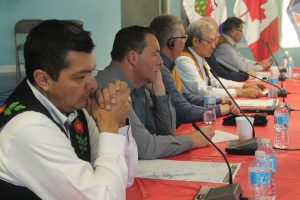The GNWT announced Wednesday that federal funding has been conditionally approved for the construction of a long-awaited all-season road in the territory’s Tłı̨chǫ region.
The two-lane, 97-kilometer road would provide direct access to the community of Whatì from Highway 3, replacing the ice road built to connect the Tłı̨chǫ region to Yellowknife and surrounding areas for three months of the year.

Along with providing year-round transportation for the community, the road is expected to extend ice road access by up to a month to the communities of Gamèti and Wekweètì, north of Whatì.
But exactly how much the road will cost has yet to be announced.
That’s because the road’s construction contract is being put out to tender by the GNWT for private companies to bid on, though previous reports have estimated costs to come in around $150 million.
Federal funding will cover up to 25 per cent of eligible costs through the Public-Private Partnership, or P3, Canada Fund, while the GNWT will cover the rest if given approval by the legislative assembly and private sector.
The funding is conditional upon the project going through an environmental assessment, a Request for Qualifications (RFQ) and subsequent Request for Proposal (RFP) process.
The RFQ is expected to be released by the territorial government in February.
“Hopefully we get through the RFQ and RFP process and we get through the regular rest of the approval process,” said Wally Schumann, the territory’s transportation minister.
“We’d like to see some work start even as early as this winter.”
Local employment
The release of the RFQ next month will start the process to see bidders for a 29-year contract.
The first four years of the government contract will be for construction, with the rest covering year-round maintenance and operation of the road.
Several hundred workers are expected to be employed during construction. Once completed, numbers will drop significantly to around 10 to 12 full-time employees.
Sandy Kalgutkar, deputy secretary of the Financial Management Board, says the GNWT is working with the Tłı̨chǫ government to determine what percentage of the winning contractor’s employees should be from the local region.
“There will be criteria that we’re working on with the Tłı̨chǫ government to develop milestones that certain companies will have to meet to ensure that there is local involvement,” said Kalgutkar.
“Even when the project goes into operation, the project agreement the government will have with the company will have mechanisms in there to ensure that local involvement and local employment are being met.”
The contract is not expected to be awarded until the summer of 2018.
Construction is estimated to take up to four years, but Schumann expects it will be pushed along faster.
Better quality of life

For the nearly 500 people living in Whatì, Chief Alfonz Nitsiza says the road will not only create local jobs, but increase their quality of life.
“The cost of living will be reduced,” he said. “The benefit will be that it will be cheaper to get supplies and things like that, and easier access to go out.”
Whatì is currently a fly-in community. For three months in winter the community is connected by an ice road to larger regions. The rest of the time, food and supplies have to be flown in and anyone traveling has to take an expensive flight out.
“Resulting food prices [are] often 50 per cent higher than in Yellowknife” read a GNWT press release.
To 62-year-old Mary Ann Jeremick’ca, the road is ‘a big deal’.
“In some ways it’s good, and not so good in some ways, but we cannot keep isolating ourselves,” she said. “We need the road.”

Jeremick’ca, a lifelong resident of Whatì, says she’s grown accustomed to having limited access to resources in her community.
With the opportunities the road provides, she’s excited for prices to go down.
She’s also looking forward to a more affordable way to see three of her children and grandchildren, all of whom live in Yellowknife.
“[I’m] waiting for them to come every winter,” said Jeremick’ca. “It’s only three months, so we are taking advantage of the road going back and forth.”
With the all-season road, Jeremick’ca’s happy she’ll have the option to see them more.
However, she expressed concern about more than just her grandchildren driving in.
“There’s substance abuse that comes in … but on the other hand we need the road in order to get the supplies that we need for the whole year,” she said.
Concern of substances coming in
Premier Bob McLeod agreed that with the all-season road, it is possible that alcohol and other substances could make their way into the community.
“That’s a normal thing that comes out in our experience in building roads,” he said.
Nitsiza, for his part, doesn’t seem overly concerned.
“Whatì is a dry community and has been for many years, but that doesn’t really stop people from bringing in alcohol or drugs,” he said.
According to Nitsiza, the community has not had any major issues with alcohol or drugs outside of New Year’s Eve, and he doesn’t expect that to change.
To be sure, part of the assessment process for the project will consider social issues such as substance abuse and the potential for trafficking, and what can be done to deter it.
“There are normally recommendations to that effect and the project proponents will have to respond to those recommendations,” said McLeod.




